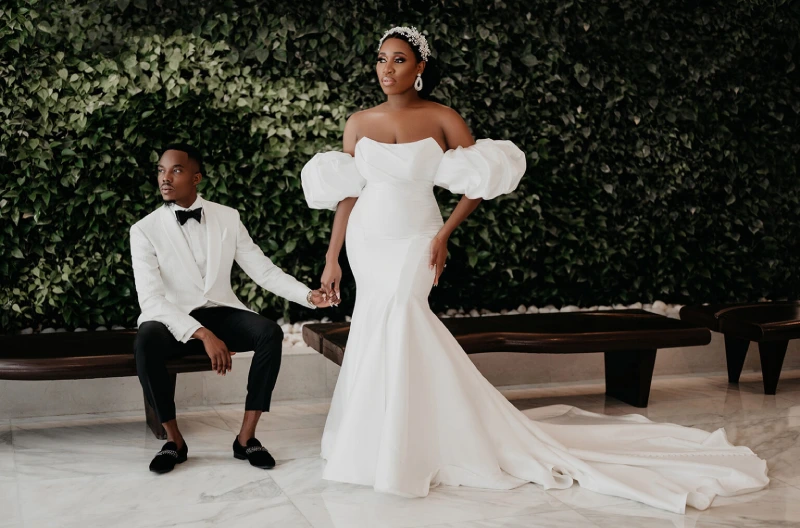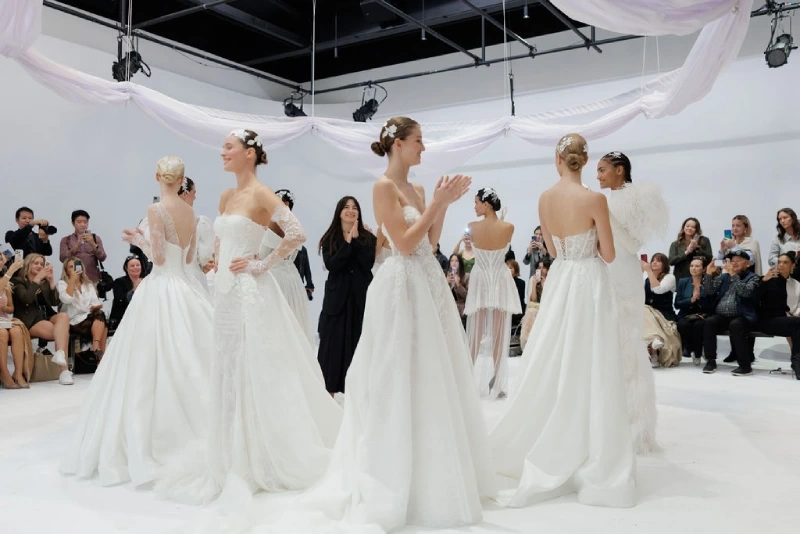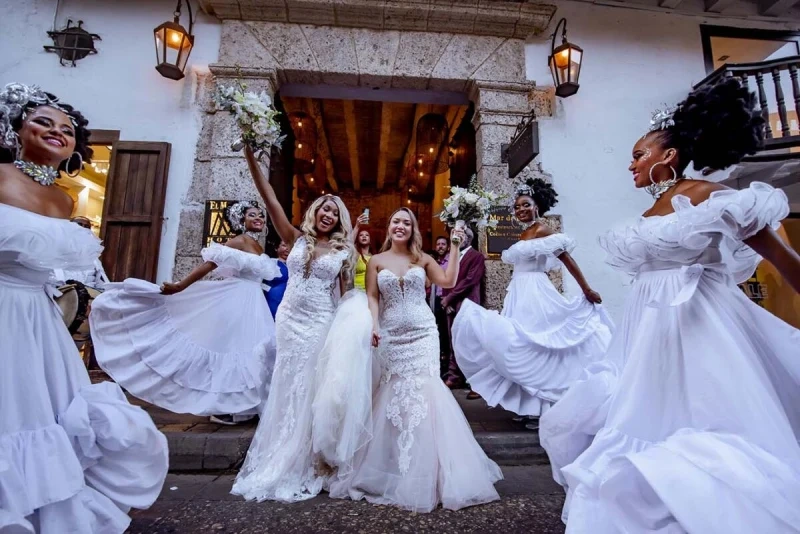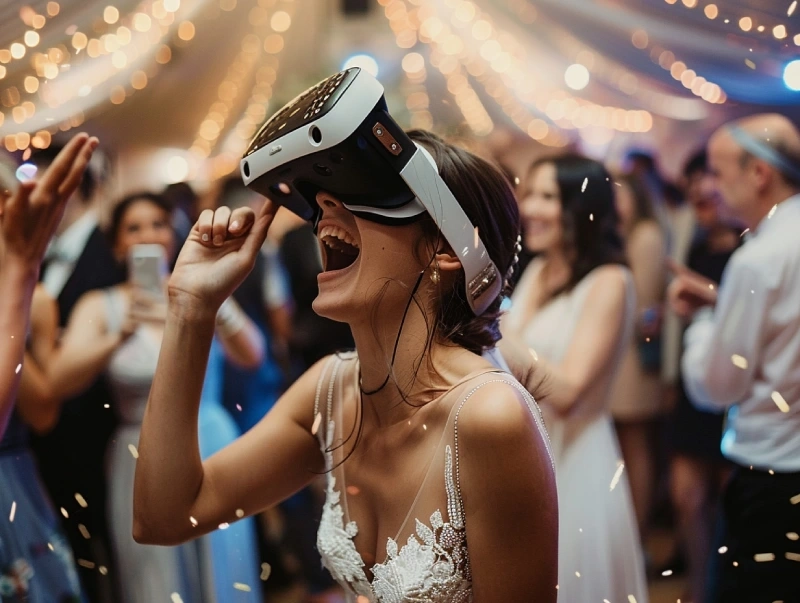Step into the future of wedding fashion with our guide to the top trends to watch in 2025. From bold, unexpected colors to unconventional silhouettes, the wedding fashion landscape is set to undergo a major evolution in the coming years. Gone are the days of traditional white gowns and simple black tuxedos. Instead, prepare to be wowed by an array of daring and unique styles that speak to the individuality and personality of the couple.
Incorporate sustainable and eco-friendly fabrics into your wedding day ensemble, as eco-consciousness becomes increasingly important in the fashion industry. Embrace unexpected textures and playful embellishments that add depth and visual interest to your look. As gender norms continue to be challenged, expect to see more gender-fluid attire and inclusive designs that cater to all couples.
Whether you’re a bride, groom, or guest, stay ahead of the curve with our expert predictions for the future of wedding fashion. Get ready to be inspired and redefine what it means to make a fashion statement on the most special day of your life.
Historical Overview of Wedding Fashion
Wedding fashion has long been a reflection of cultural norms, societal values, and individual expression. Historically, the concept of a wedding gown can be traced back to ancient civilizations, where brides wore garments that symbolized their status and wealth. In Ancient Rome, brides donned tunics and veils, while in Medieval Europe, the color of the gown was often influenced by the bride’s social standing. The tradition of wearing white, popularized by Queen Victoria in the 19th century, marked a significant shift in wedding attire, symbolizing purity and new beginnings. This single event transformed the wedding dress into a statement piece, leading to the iconic white gown that many still associate with weddings today.
As the years progressed, wedding fashion became more diverse, reflecting changes in culture, style, and society. The roaring twenties introduced flapper styles that emphasized freedom and rebellion, while the post-war era saw a return to more traditional, feminine silhouettes. The 1960s and 1970s brought about revolutionary changes, with brides opting for shorter hemlines and non-traditional fabrics, embodying the counterculture movement. With each decade, wedding fashion has evolved, influenced by everything from economic conditions to social movements, laying the groundwork for today’s trends.
Entering the modern era, wedding fashion has become a platform for self-expression. Couples are increasingly choosing garments that resonate with their personal style rather than adhering to strict traditions. This shift has led to a more inclusive and varied representation of wedding attire, where brides and grooms can explore colors, styles, and designs that truly reflect their identity and love story. As we look toward the future, the evolution of wedding fashion will continue to embrace diversity, individuality, and creativity.
Current Trends in Wedding Fashion
As we stand on the brink of a new era in wedding fashion, current trends highlight a shift toward personalization and innovation. One of the most notable trends is the rise of non-traditional colors. While white has been the quintessential choice for brides, bold hues such as deep reds, rich greens, and even vibrant floral prints are gaining popularity. These colors allow couples to express their unique personalities and set the tone for their special day. Additionally, mix-and-match bridal parties are becoming a norm, where bridesmaids and groomsmen wear coordinated but individually styled outfits, further emphasizing the theme of personalization.
Another significant trend is the move towards relaxed silhouettes and comfortable fabrics. The traditional structured gown is giving way to fluid designs that allow for ease of movement and comfort, especially for outdoor and destination weddings. Lightweight materials and breathable fabrics are being favored, as couples prioritize comfort while still maintaining elegance. This trend reflects a broader cultural shift toward prioritizing experiences over rigid traditions, allowing couples to enjoy their special day without the constraints of formal attire.
Additionally, the inclusion of technology in wedding fashion is transforming the way couples shop for their attire. Virtual fitting rooms and augmented reality apps enable brides and grooms to try on outfits from the comfort of their homes, making the shopping experience more accessible and enjoyable. Social media platforms, particularly Instagram and Pinterest, have become vital sources of inspiration, allowing couples to discover new designers and trends at an unprecedented pace. As these trends continue to evolve, they underscore the growing desire for individuality and innovation in wedding fashion.
Factors Influencing the Evolution of Wedding Fashion
Several factors contribute to the ongoing evolution of wedding fashion, with cultural shifts and societal changes playing pivotal roles. One of the most influential factors is the increasing acceptance and celebration of diverse identities and relationships. The rise of LGBTQ+ visibility and rights has prompted designers to create more inclusive wedding attire, allowing couples to choose garments that reflect their unique identities. This shift has led to a wider array of styles, colors, and silhouettes in wedding fashion, breaking down the traditional gender norms that have long dictated wedding attire.
Another significant factor is the growing awareness of sustainability and ethical practices in the fashion industry. As environmental concerns take center stage, many couples are seeking ways to incorporate eco-friendly choices into their wedding attire. This has led to the emergence of designers who specialize in sustainable fabrics and practices, championing the use of organic materials and zero-waste designs. Couples are increasingly prioritizing brands that align with their values, making conscious decisions that reflect their commitment to the planet.
Lastly, the influence of global fashion trends cannot be overlooked. As the world becomes more interconnected, styles from various cultures and regions are blending into mainstream wedding fashion. This globalization allows for a rich tapestry of influences, from intricate embroidery and traditional textiles to modern, minimalist designs. Couples are now more inclined to draw inspiration from different cultures, resulting in a celebration of diversity that reflects a broader understanding of what wedding fashion can encompass. This ongoing evolution signifies a move away from conventional norms, embracing a more inclusive and dynamic approach to wedding attire.
Prediction of Wedding Fashion Trends for 2025
Looking ahead to 2025, wedding fashion is poised for even greater innovation and creativity. One of the most anticipated trends is the continued embrace of bold colors and patterns. As couples seek to showcase their individuality, expect to see an explosion of vibrant hues and unique prints in wedding attire. From floral motifs to geometric designs, the days of solely relying on white or ivory gowns are fading, and couples will be empowered to express their personal aesthetics through their choice of colors and patterns.
In addition to color, the trend toward gender-fluid and androgynous designs will likely gain momentum. As societal norms continue to evolve, wedding fashion will reflect a more inclusive approach that caters to all identities. This shift will result in a broader range of options for all couples, allowing them to move beyond traditional gendered attire. Expect to see a rise in tailored suits, jumpsuits, and dresses that blur the lines between masculine and feminine, allowing couples to express their true selves on their wedding day.
Furthermore, technology will play an increasingly significant role in wedding fashion by 2025. From 3D printing to virtual reality experiences, advancements in technology will enable designers to create groundbreaking garments that were previously unimaginable. Customization will become more accessible, allowing couples to design their own attire, incorporating personal elements that tell their unique love story. As the industry continues to innovate, we can expect an exciting future where technology and fashion merge seamlessly to create unforgettable wedding experiences.
Sustainable and Eco-Friendly Wedding Fashion
Sustainability is no longer just a buzzword; it has become a cornerstone of modern wedding fashion. As awareness of environmental issues grows, couples are increasingly seeking eco-friendly alternatives for their wedding attire. This trend encompasses a range of practices, from choosing sustainable fabrics such as organic cotton, hemp, and bamboo to opting for vintage or second-hand garments. By making conscious choices, couples can reduce their environmental impact while still looking stunning on their special day.
In addition to fabric choices, sustainable wedding fashion also involves ethical production practices. Many designers are now prioritizing fair labor conditions and environmentally responsible manufacturing processes. This shift towards ethical fashion not only addresses environmental concerns but also supports artisans and local communities. Couples are encouraged to research brands that align with their values, ensuring that their wedding attire is not only beautiful but also socially responsible.
Moreover, the concept of “worn once” wedding attire is gaining traction. Couples are increasingly opting to rent their wedding outfits instead of purchasing them outright, allowing them to enjoy the luxury of high-end fashion without the hefty price tag or environmental impact. This trend not only promotes sustainability but also encourages creativity, as couples can experiment with different styles without the pressure of permanent commitment. As we move forward, the integration of sustainability into wedding fashion will become more prevalent, allowing couples to celebrate their love while honoring the planet.
Technology and Wedding Fashion
The intersection of technology and wedding fashion is a fascinating development that is reshaping the industry. Innovations in design software and 3D printing have opened up new possibilities for custom wedding attire, allowing couples to create unique pieces tailored to their specifications. With the help of advanced technology, designers can experiment with intricate patterns and structures that were once difficult to achieve. This trend is not only about aesthetics; it also allows for greater personalization, giving couples the opportunity to incorporate meaningful elements into their garments.
Virtual reality and augmented reality are also changing the way couples shop for their wedding attire. Many bridal boutiques are now offering virtual fitting experiences, enabling brides and grooms to try on dresses and suits from anywhere in the world. This technology not only streamlines the shopping process but also reduces the time and energy spent traveling to multiple stores. Couples can visualize how different styles will look on them without the constraints of physical fittings, making the experience more enjoyable and less stressful.
Additionally, social media platforms continue to influence wedding fashion trends, with platforms like Instagram and TikTok serving as vital sources of inspiration. Influencers and fashion bloggers showcase innovative designs and styles, allowing couples to discover emerging trends and designers. The power of social media has democratized fashion, enabling anyone to share their unique wedding styles and experiences. As we embrace the future of wedding fashion, technology will undoubtedly play a pivotal role in shaping how couples express their love and individuality on their special day.
Celebrity Influences on Wedding Fashion
Celebrities have always had a profound impact on fashion trends, and wedding attire is no exception. High-profile weddings often serve as a platform for showcasing the latest designs and styles, capturing the attention of brides and grooms worldwide. Iconic moments from celebrity weddings, such as Kate Middleton’s stunning Alexander McQueen gown or Meghan Markle’s elegant Clare Waight Keller dress, have set trends that resonate with couples long after the events have passed. These influential figures often collaborate with top designers to create one-of-a-kind pieces, igniting a desire among fans to replicate or be inspired by their style choices.
Moreover, celebrity weddings frequently highlight the importance of personalization and uniqueness in wedding fashion. Many stars choose to embrace unconventional styles, defying traditional norms and opting for bold colors, unique silhouettes, or even bespoke pieces that reflect their personal taste. This shift encourages couples to think outside the box and consider their own styles when planning their weddings. The influence of celebrities can inspire couples to take risks and embrace their individuality, leading to a more diverse representation of wedding fashion.
Social media plays a crucial role in amplifying celebrity influences on wedding fashion, as fans eagerly follow their favorite stars on platforms like Instagram. Influencers and celebrities alike share their wedding planning journeys, providing a behind-the-scenes look at their attire choices and styling decisions. This accessibility allows couples to draw inspiration from their favorite celebrity weddings, tailoring those ideas to create their unique vision. As the influence of celebrities continues to shape wedding fashion, we can expect to see more daring and personalized designs in the years to come.
Cultural and Traditional Influences on Wedding Fashion
Cultural and traditional influences have always played a vital role in shaping wedding fashion. Each culture brings its own unique customs, colors, and attire to the celebration of love, creating a rich tapestry of styles around the world. For instance, in many Asian cultures, brides often wear red as a symbol of joy and prosperity, while in Western cultures, white symbolizes purity. These traditional colors are often accompanied by intricate designs, such as embroidery and beading, that reflect the heritage and stories of each culture. As globalization continues to blur cultural boundaries, we are witnessing a beautiful fusion of styles, allowing couples to incorporate meaningful elements from various traditions into their wedding attire.
Moreover, the revival of traditional crafts and techniques is becoming increasingly popular in modern wedding fashion. Many designers are collaborating with artisans to create garments that honor cultural heritage while incorporating contemporary styles. This not only supports craftsmanship but also allows couples to wear pieces that tell a story, celebrating their roots and the journey of their relationship. By embracing cultural influences, couples can craft weddings that are deeply personal and meaningful, creating a unique blend of tradition and modernity.
Additionally, as society becomes more accepting of diverse identities and relationships, wedding fashion is evolving to reflect this inclusivity. Couples are increasingly exploring non-traditional attire that honors their cultural backgrounds while also embracing their unique identities. This shift encourages creativity and allows couples to break free from rigid norms, resulting in a more vibrant and diverse representation of wedding fashion. As we move forward, the influence of culture and tradition will continue to shape the landscape of wedding fashion, creating a beautiful tapestry of styles that honors love in all its forms.
Conclusion and Final Thoughts on the Future of Wedding Fashion in 2025
As we look toward the future of wedding fashion in 2025, it is clear that the industry is poised for exciting transformations. The ongoing evolution of styles, colors, and silhouettes reflects a broader cultural shift toward individuality, inclusivity, and sustainability. Couples are no longer confined to traditional norms; instead, they are empowered to express their unique identities and love stories through their attire. This movement marks a significant departure from the past, where conformity often overshadowed personal expression.
Sustainability will continue to play a crucial role in shaping wedding fashion, with eco-conscious choices becoming the norm rather than the exception. Couples are increasingly prioritizing ethical practices and sustainable materials, ensuring that their celebrations are not only beautiful but also responsible. This commitment to the planet will inspire designers to innovate and create garments that align with these values, paving the way for a more sustainable future.
Ultimately, the future of wedding fashion is bright and filled with possibilities. As technology advances and cultural boundaries continue to blur, we can expect to see an even richer tapestry of styles that honor love in all its forms. Couples are invited to embrace their individuality, draw inspiration from diverse influences, and create celebrations that reflect their unique journeys. As we step into 2025, let us celebrate the evolution of wedding fashion and the beautiful expressions of love it encompasses.





